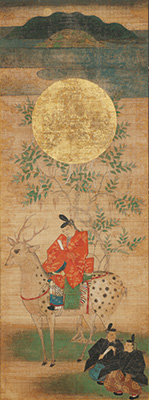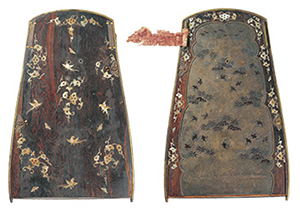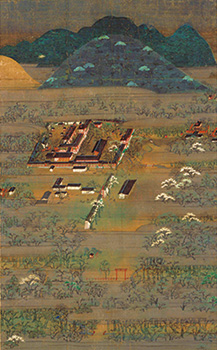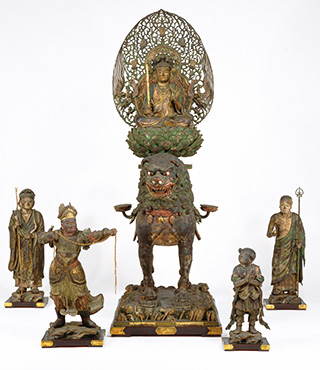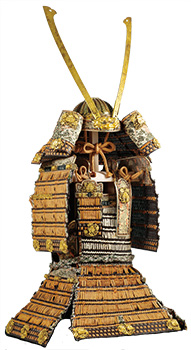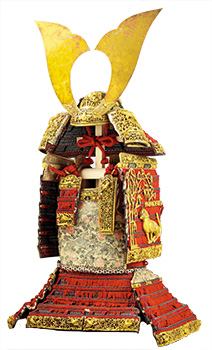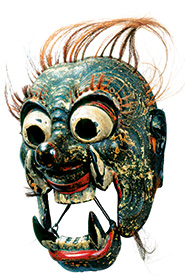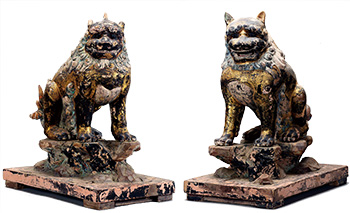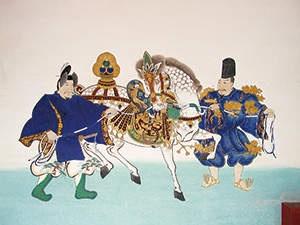2017年2月16日(木)、入場者が10万人に達しました。
1089ブログ「春日大社 千年の至宝」 展覧会の見どころなどを紹介しています。
「かわいい!春日の動物たち」投票結果(投票期間:2017年2月1日(水)~3月12日(日))
東京国立博物館 資料館 特別展「春日大社 千年の至宝」関連図書コーナー設置
展覧会のみどころ
第1章 神鹿の杜
春日大社の草創は、武甕槌命(たけみかづちのみこと)が鹿に乗り、常陸国鹿島(ひたちのくにかしま)から春日の地に降り立たれたことに始まります。本章では、春日大社の創祀を物語る歴史資料や絵画作品、そして神々しくも親しみにあふれる「神鹿」に関わる美術などを展示します。
鹿島立神影図(かしまだちしんえいず)
南北朝~室町時代・14~15世紀
春日大社蔵
武甕槌命が鹿に乗り、春日の地に降臨した様子を描いています。春日大社の草創を物語る作例で、後小松天皇奉納と伝えられています。
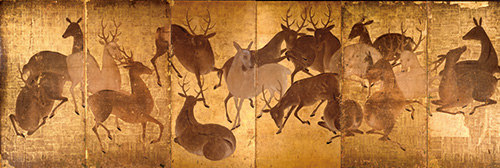
鹿図屏風 (しかずびょうぶ)
江戸時代・17世紀
春日大社蔵
輝かしい金地に様々な姿態をみせる牡鹿、牝鹿の群れを描いています。なかにはかわいい子鹿の姿も見えます。
展覧会のみどころトップへ
第2章 平安の正倉院
神々の調度品として奉納された古神宝。春日大社には平安時代に奉納された本宮御料(ほんぐうごりょう)と若宮御料(わかみやごりょう)が伝わり、「平安の正倉院」とも呼ばれています。本章では、王朝時代の雅と美を今に伝える国宝の品々をご紹介します。

国宝 本宮御料古神宝類 蒔絵箏(ほんぐうごりょうこしんぽうるい まきえのこと)
平安時代・12世紀
春日大社蔵
[後期展示:2017年2月14日(火)~3月12日(日)]
金、銀、銅の研出蒔絵(とぎだしまきえ)による流水文や飛び交う鳥や蝶が描かれています。技術を凝らし、王朝意匠の粋を今に伝える平安時代漆芸品の最高傑作です。
国宝 若宮御料古神宝類 平胡簶(わかみやごりょうこしんぽうるい ひらやなぐい)
平安時代・12世紀
春日大社蔵
[前期展示:2017年1月17日(火)~2月12日(日)]
平胡簶とは矢を差し、携帯する用具です。背板両面には螺鈿などを用い尾長鳥や宝相華文が表わされています。左大臣となった藤原頼長の所用品です。
 国宝 金地螺鈿毛抜形太刀(きんじらでんけぬきがたたち)
国宝 金地螺鈿毛抜形太刀(きんじらでんけぬきがたたち)
平安時代・12世紀
春日大社蔵
[展示期間:2017年1月17日(火)~2月19日(日)]
柄(つか)や鍔(つば)などの多くの金具は金無垢に文様を彫り出し、鞘(さや)は金粉を蒔き、螺鈿で雀を追う竹林の猫を表現しています。まばゆく輝く黄金の太刀です。
展覧会のみどころトップへ
第3章 春日信仰をめぐる美的世界
草創以降、貴族をはじめとする多くの人々が春日の地に参詣し、祈りを捧げてきました。また、神と仏が一体であるとする神仏習合の思想を背景に、仏法を守護する春日の神々への信仰も広がりをみせていきます。本章では、春日の神々への祈りを表わした選りすぐりの名品を展示します。
春日宮曼荼羅(かすがみやまんだら)
鎌倉時代・13世紀
東京国立博物館蔵
[前期展示:2017年1月17日(火)~2月12日(日)]
春日大社の社殿を中心に、画面上部に御蓋山、春日山、若草山を配しています。聖地・春日野を一望にする礼拝画の大作です。
重要文化財 文殊菩薩騎獅像および侍者立像(もんじゅぼさつきしぞうおよびじしゃりゅうぞう)
康円作
鎌倉時代・文永10年(1273)
東京国立博物館蔵
春日大社の祭神のうち、若宮は文殊菩薩と同体と考えられていました。神と仏の一体化を象徴する作例で、興福寺に伝来したものです。
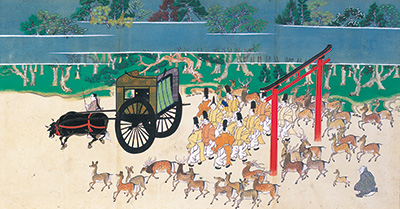
春日権現験記絵(春日本)巻十二(かすがごんげんげんきえ かすがぼん) (部分)
江戸時代・文化4年(1807)
春日大社蔵
[2017年1月17日(火)~2月12日(日)と2月14日(火)~3月12日(日)で場面替あり]
春日の神々の霊験を描く全二十巻の絵巻です。春日本は松平定信の指示で制作されました。鹿に囲まれる牛車には春日三宮が化身した地蔵菩薩の姿があります。
展覧会のみどころトップへ
第4章 奉納された武具
春日大社には多くの武具が奉納されています。こうした奉納品が伝わったのも、春日大社が公家・武家をはじめ多くの人々の深い祈りに支えられてきたことを物語っています。本章では、春日大社に伝わる国宝の甲冑や刀剣などを一堂にご覧いただきます。
国宝 赤糸威大鎧(梅鶯飾)(あかいとおどしおおよろい うめうぐいすかざり)
鎌倉時代・13世紀
春日大社蔵
[展示期間:2017年1月17日(火)~2月19日(日)]
梅や鶯などを透彫にした金物の華やかさが、兜や胴の力強さと見事に融合した鎌倉時代を代表する鎧です。
国宝 赤糸威大鎧(竹虎雀飾)(あかいとおどしおおよろい たけとらすずめかざり)
鎌倉~南北朝時代・13~14世紀
春日大社蔵
[後期展示:2017年2月14日(火)~3月12日(日)]
鮮烈な赤の威毛と、細かい彫金技術をみせる鍍金の金物が目にもまばゆい華やかさをみせています。
国宝 沃懸地酢漿紋兵庫鎖太刀(いかけじかたばみもんひょうごぐさりたち)
鎌倉時代・13世紀
春日大社蔵
[後期展示:2017年2月14日(火)~3月12日(日)]
鞘と兵庫鎖の部分に酢漿紋を施す、力強くも優美な刀剣です。昭和5年(1930)に本殿より撤下された一振です。
展覧会のみどころトップへ
第5章 神々に捧げる芸能
春日大社では数多くの神事、祭事が執り行われていますが、その中でも12月に行なわれる若宮おん祭は国の重要無形民俗文化財に指定されています。本章では、こうした祭礼の際に神前に奉納された舞楽や能など、芸能に関わる作品をご紹介します。
左:納曽利装束(なそりしょうぞく)
江戸時代・17世紀
春日大社蔵
[前期展示:2017年1月17日(火)~2月12日(日)]
右:重要文化財 舞楽面 納曽利(ぶがくめん なそり)
平安時代・12世紀
春日大社蔵
納曽利は龍が舞い遊ぶ様を表わしたとされる舞です。舞楽面は平安時代にさかのぼる作で、大きく見開いた眼や顎を別材で作り、舞の動きに合わせて表情に変化が出る仕組みになっています。
展覧会のみどころトップへ
第6章 春日大社の式年造替
春日大社では社殿の建て替えや修繕が約20年に一度行なわれ、平成28年(2016年)に迎える御造替は60回目を数えます。本章では、御造替に関わる記録とともに、今回の御造替で御徹下(ごてっか)され注目を浴びた獅子・狛犬などをご覧いただきます。
(注)御撤下:神に奉られていた御道具などが役目を終え、神殿から下ろされること。
獅子・狛犬(第一殿)(しし・こまいぬ だいいちでん)
鎌倉時代・13世紀
春日大社蔵
御本殿をお護りしていた獅子・狛犬で、今回の御造替で御撤下されました。四対八軀のうち六軀は鎌倉時代の制作と考えられます。
御間塀(おあいべい)
昭和50年(1975)
春日大社蔵
四つの本殿の間にある御間塀に描かれた壁画で、絵馬の源流ともいわれます。昭和50年、58回目の造替の際に新調されたものです。
展覧会のみどころトップへ


